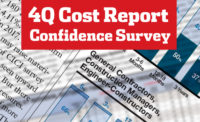The market recession has severely tested the confidence of the normally optimistic construction industry. Four years of struggling markets have taken a toll. However, the slow-but-steady recovery of the U.S. economy has many firms in the industry now believing that the worst is behind them and that a broad recovery is poised to begin. The recovery of the industry’s optimism can be seen in the most recent ENR Construction Industry Confidence Index (CICI) survey.

The CICI measures executive sentiment about the current market as well as projections for where it will be in the next three to six months and over a 12- to 18-month period. The index is based on responses to surveys sent out to more than 3,000 U.S. firms on ENR’s lists of the leading contractors, subcontractors and design firms. The latest results are based on a survey conducted from Feb. 22 to March 12.
The first-quarter 2012 CICI rose to 58 on a scale of 100, up 16 points from 42 in the last quarter. (A CICI rating of 50 would represent a stable market.) The 464 executives of large construction and design firms responding to the survey believe the market has stabilized and is beginning to show signs of recovery.
The CICI also measures sentiment about the overall U.S. economy as a leading indicator of future trends in construction. In the first quarter, confidence in the U.S. economy rose to a CICI rating of 64, from 49 in the last quarter, showing that respondents in the industry believe the economy is on the right track.
Another sign of the industry’s optimism is that, while only 19% of respondents say the market is continuing to decline, 21% believe the market now is improving. This marks the first time since ENR began to conduct the CICI survey in the first quarter of 2009 that more respondents believe the market is growing than believe it is still declining. While respondents are not ebullient about near-term prospects, 31% believe the market will improve in three to six months’ time, compared to 12% that believe it will still be in decline.
However, the industry’s expectations for the market in 2013 may be cause for real excitement. Only 6% of respondents believe the market will continue to be in decline in 12 to 18 months, while 53% say it will be improving.
Applying the CICI formula to individual market sectors shows that respondents believe the private-sector markets will lead the recovery. The petroleum market is perceived to be the strongest, with a CICI rating of 76, up from 69 in the fourth quarter of 2011. Multi-unit residential (up 4 points) and power (up 6 points) both came in at 71. Health care was also seen as a strong market, rising 2 points to 69.
Some of the markets most affected by the recession gained the most in the first quarter survey. The retail market, once the lowest-rated market, rose 8 points to a CICI rating of 51, showing some optimism that this sector finally has stabilized. The distribution and warehouse market also rose by 8 to 51, while the commercial office market was up eight points to 47. The only market to fall was the entertainment and theme-park sector, which dropped a point to 41.
Markets sectors that are predominantly in the public sector generally rose, but not to the extent of their private sector counterparts. The transportation sector had been perceived as one of the strongest markets in the recession until federal stimulus money began to run out, causing its rating to plunge. But in this quarter, the transportation market rebounded to rise five points to 52. The water & sewer market rose two points to a 53 rating. Both now are perceived as stabilizing, despite state and local budget shortfalls and federal funding uncertainties.
However, the K-12 education sector is seen by survey participants as still in decline, rising only a single point to 44. It is now considered the second weakest market sector behind only the entertainment and theme park sector. The higher education market was unchanged at 53.



Post a comment to this article
Report Abusive Comment